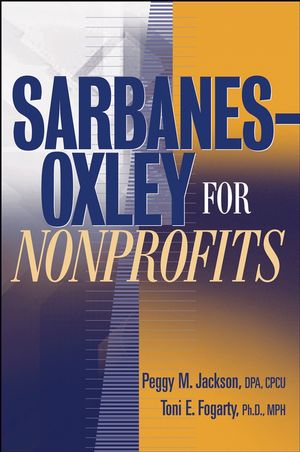Sarbanes-Oxley for Nonprofits: A Guide to Building Competitive AdvantageISBN: 978-0-471-69788-6
Hardcover
256 pages
April 2005
 |
||||||
About the Authors.
Preface.
Chapter 1: Overview of the Legislation and Its Implications for Nonprofits.
What Is the Sarbanes-Oxley Legislation About?
Relevance of SOX to Nonprofits.
Current Legislative Environment for Nonprofits.
Conclusion.
Endnotes.
Chapter 2: Safeguarding Your Nonprofit’s Financial Resources and Assets: Establishing Auditor Independence and Audit Committee Competence.
SOX Titles II and III.
The Value of Accurate Financial Statements.
The Importance of a Good Audit.
The Board’s Responsibility Regarding the Financial Statements.
Conclusion.
Chapter 3: Reading and Interpreting Financial Statements.
Balance Sheet.
Statement of Operations.
Statement of Changes in Net Assets.
Statement of Cash Flows.
Financial Statement Analysis.
Conclusion.
Chapter 4: Form 990: Unnecessary Paperwork or a Useful Tool?
What Are Form 990 and Form 990-EZ?
Why Is Form 990 Important?
Management’s Role in Improving Form 990: Creating a Good Internal Control System.
The Board’s Role in Form 990.
Conclusion.
Chapter 5: SOX Sections VIII and XI: Document Retention and Whistleblower Protection Obligations.
Whistleblower Protection.
Creating a Confidential Reporting System.
Document Retention, Archiving, and Retrieval.
First Steps: Beginning the Process.
Conclusion.
Chapter 6: >Raising the Bar of Accountability: SOX Best Practices and the Board.
Legislative Environment: Best Practices and Governance.
New Expectations for Board Oversight and Governance.
Higher Expectations for Board Membership and Deliberations.
SOX and the Board: Higher Performance and Greater Accountability.
Championing SOX Best Practices: The Board’s Governance Role.
Conclusion.
Chapter 7: SOX Best Practices and Organizational Culture: Changing the Environment.
The Nonprofit’s Organizational Culture and the Adaptation of SOX Best Practices.
Introducing Change.
Nonprofit Board Culture.
Strategies for Introducing Change in the Board Culture.
Conclusion.
Endnote.
Chapter 8: A Platinum Operating Standard Starts with Good Bones.
SOX Best Practices: Moving to a Platinum Operating Standard.
What Are Platinum Operating Standards?
Review of Internal Controls.
Conducting the Review of Internal Controls.
Content and Structure of the Review of Internal Controls Report.
Conclusion.
Endnote.
Chapter 9: Creating a Competitive Advantage: Leveraging SOX Best Practices.
Competitive Advantages of Being in Compliance with Sarbanes-Oxley Best Practices.
Conclusion.
Endnotes.
Chapter 10: SOX Best Practices for Small Nonprofits.
Five Myths That Hold Small Nonprofits Back.
Adopting SOX Best Practices.
Scaling the SOX Best Practices to Fit the Needs of Small Nonprofits.
Keys to Success in Customizing SOX Best Practices.
Conclusion.
Appendices: Best Practices: Checklists, Worksheets, and Sample Documents.
Appendix A: Working Through the Four Basic Financial Statements.
Balance Sheet.
Statement of Operations.
Statement of Changes in Net Assets.
Statement of Cash Flows.
Appendix B: Whistleblower Protection Policy.
Appendix C: Document Retention and Storage Protocols.
Document Retention Policy—Talking Points.
Writing the Policy—Talking Points.
Special Designations for Sensitive Documents.
Storing and Archiving the Documents.
Testing the System.
Appendix D: Audit Committee Procedures and Protocols.
Audit Committee.
Composition of the Committee.
Committee Functions and Deliverables.
Appendix E: Conflict of Interest Policy.
Talking Points.
Sample Conflict of Interest Letter.
Appendix F: Code of Ethics for Board and Senior Management.
Talking Points.
Sample Code of Ethics for a Nonprofit Board Member.
Appendix G: Board of Directors—Governance Profile and Performance Expectations.
Oversight and Policy Making.
Term Limits.
Summary of Board Committees’ Descriptions and Performance Objectives.
Process for Board Member Nomination and Election.
Appendix H: Board Orientation Session.
Outline of Curriculum.
Board Binder Contents.
Appendix I: Review of Internal Controls Report and Recommendations.
Introduction.
Systems.
Recommendations and Time Line.
Appendix J: Risk Management Plan.
Profile.
Risk Management Worksheets.
Worksheet 1—List Areas of Concern.
Worksheet 2—Tier 1 and Tier 2 Risks.
Worksheet 3—Strategies for Dealing with Risk.
Worksheet 4—Time Line.
Worksheet 5—Risk Administration and Monitoring.
Worksheet 6—Risk Management Plan Template: Table of Contents.
Sample Risk Management Plan: Table of Contents.
Appendix K: Business Continuity Plan.
Emergency Protocols.
Contact Information for Board Members and Staff.
Business Resumption Strategies for Each Department within Your Nonprofit.
Communication.
Financial Services.
Vendors.
Service Providers—Utilities, Water, Governmental Agencies.
If Your Nonprofit Needs to Relocate.
Appendix L: Bibliography.
Index.



